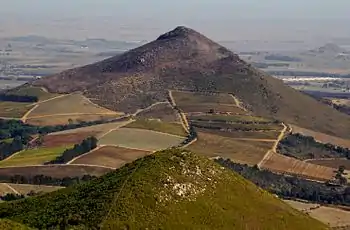Klapmuts
Klapmuts is the name of both a hill, and a town which formed at its foot. They are located in Cape Winelands District Municipality in the Western Cape province of South Africa.[2]
Klapmuts | |
|---|---|
 Klapmuts hill ("Klapmutskop") from which the town gets its name. | |
 Klapmuts  Klapmuts | |
| Coordinates: 33°48′20″S 18°52′11″E | |
| Country | South Africa |
| Province | Western Cape |
| District | Cape Winelands |
| Municipality | Stellenbosch |
| Area | |
| • Total | 1.76 km2 (0.68 sq mi) |
| Population (2011)[1] | |
| • Total | 7,703 |
| • Density | 4,400/km2 (11,000/sq mi) |
| Racial makeup (2011) | |
| • Black African | 33.5% |
| • Coloured | 64.2% |
| • Indian/Asian | 0.3% |
| • White | 1.0% |
| • Other | 1.0% |
| First languages (2011) | |
| • Afrikaans | 72.2% |
| • Xhosa | 21.6% |
| • Sotho | 2.4% |
| • English | 1.9% |
| • Other | 1.9% |
| Time zone | UTC+2 (SAST) |
| PO box | 7625 |
Klapmuts town
Klapmuts is a little town just off the R45 road between Kraaifontein and Paarl,[3] It is well known for its surrounding wine farms. The Afrikaans Taal Museum in Klapmuts is a Georgian-style house built in the 1860s, with many exhibits from Afrikaans theatre, radio and television.[4]
In 1683 the Dutch East India Company and established a cattle stock-farm at Klapmuts. Finding Khoisan to trade with proved a difficult task so the VOC employed a chieftain named Klaas (Rank Capt) to find Khoisan and negotiate trade deals on behalf of the Company. In 1684 trading posts were established at Kuilen, Diep River, Vissers Hok, Riet Vlei, Hottentots Holland, Tygerberg and Klapmuts. [5]
Klapmutskop hill and conservancy

Klapmutskop, the isolated hill which stands over the town, is a unique combination of Shale, Sandstone, Granite and Conglomerate. Its natural vegetation is a complex mixture, due to the underlying soils. It is predominantly the threatened Swartland Shale Renosterveld as well as several other vegetation types on the other soil types. The crown of the hill has an ancient relict remnant of Afrotemperate forest with a population of rare Breede River Yellowwood trees - stunted by the unique environment.
In 2004, a conservancy was set up over the hill by the surrounding farms, which serve as curators of the area and its wildlife.[6]
| Wikimedia Commons has media related to Klapmuts. |
References
- "Main Place Klapmuts". Census 2011.
- http://za.geoview.info/klapmutskop,3365929
- "Klapmuts, Cape Winelands". SA-Venues.com. Retrieved 7 January 2014.
- "Klapmuts Information". Where To Stay. Retrieved 7 January 2014.
- History of South Africa 1486 - 1691. George McCall Theal, London 1888
- http://www.elsenburg.com/srm/landcare.html Archived 2013-01-22 at the Wayback Machine Downloadable documents on Klapmutskop conservancy
.svg.png.webp)